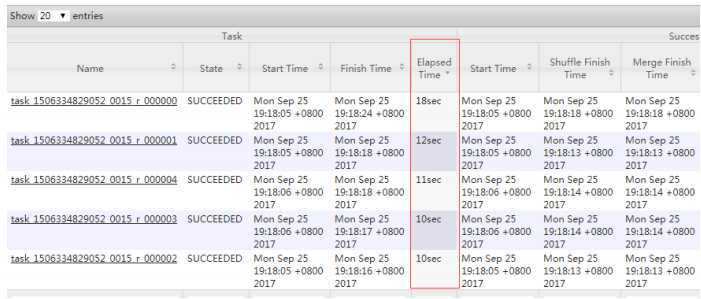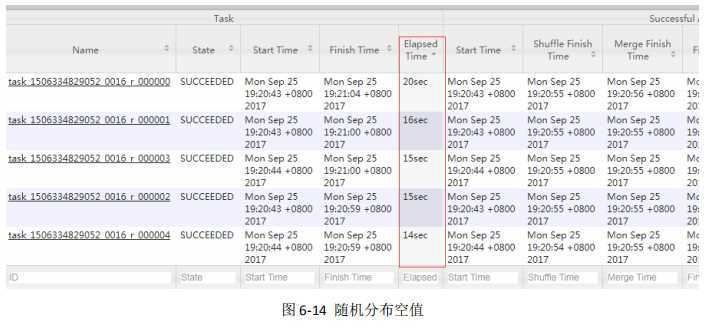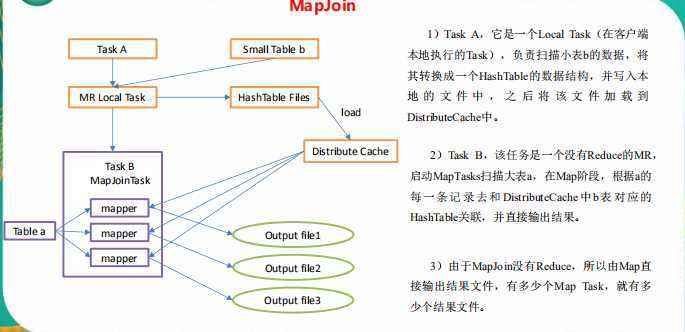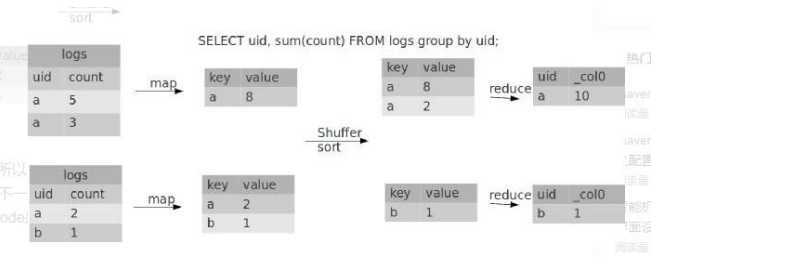<property> <name>hive.fetch.task.conversion</name> <value>more</value> <description> Expects one of [none, minimal, more]. Some select queries can be converted to single FETCH task minimizing latency. Currently the query should be single sourced not having any subquery and should not have any aggregations or distincts (which incurs RS), lateral views and joins. 0. none : disable hive.fetch.task.conversion 1. minimal : SELECT STAR, FILTER on partition columns, LIMIT only 2. more : SELECT, FILTER, LIMIT only (support TABLESAMPLE and virtual columns) </description> </property>
hive (default)> set hive.fetch.task.conversion=none; hive (default)> select * from emp; hive (default)> select ename from emp; hive (default)> select ename from emp limit 3;
hive (default)> set hive.fetch.task.conversion=more; hive (default)> select * from emp; hive (default)> select ename from emp; hive (default)> select ename from emp limit 3;
set hive.exec.mode.local.auto=true; //开启本地 mr //设置 local mr 的最大输入数据量,当输入数据量小于这个值时采用 local mr 的方式,默认 为 134217728,即 128M set hive.exec.mode.local.auto.inputbytes.max=50000000; //设置 local mr 的最大输入文件个数,当输入文件个数小于这个值时采用 local mr 的方式,默 认为 4 set hive.exec.mode.local.auto.input.files.max=10;
hive (default)> set hive.exec.mode.local.auto=true; hive (default)> select * from emp cluster by deptno; Time taken: 1.328 seconds, Fetched: 14 row(s)
hive (default)> set hive.exec.mode.local.auto=false; hive (default)> select * from emp cluster by deptno; Time taken: 20.09 seconds, Fetched: 14 row(s)
// 创建大表 create table bigtable(id bigint, time bigint, uid string, keyword string, url_rank int, click_num int, click_url string) row format delimited fields terminated by ‘\t‘; // 创建小表 create table smalltable(id bigint, time bigint, uid string, keyword string, url_rank int, click_num int, click_url string) row format delimited fields terminated by ‘\t‘; // 创建 join 后表的语句 create table jointable(id bigint, time bigint, uid string, keyword string, url_rank int, click_num int, click_url string) row format delimited fields terminated by ‘\t‘;
hive (default)> load data local inpath ‘/opt/module/datas/bigtable‘ into table bigtable; hive (default)>load data local inpath ‘/opt/module/datas/smalltable‘ into table smalltable;
set hive.auto.convert.join = false;
insert overwrite table jointable select b.id, b.time, b.uid, b.keyword, b.url_rank, b.click_num, b.click_url from smalltable s left join bigtable b on b.id = s.id;
insert overwrite table jointable select b.id, b.time, b.uid, b.keyword, b.url_rank, b.click_num, b.click_url from bigtable b left join smalltable s on s.id = b.id;
<property> <name>mapreduce.jobhistory.address</name> <value>hadoop102:10020</value> </property> <property> <name>mapreduce.jobhistory.webapp.address</name> <value>hadoop102:19888</value> </property>
// 创建原始表 create table ori(id bigint, time bigint, uid string, keyword string, url_rank int, click_num int, click_url string) row format delimited fields terminated by ‘\t‘; // 创建空 id 表 create table nullidtable(id bigint, time bigint, uid string, keyword string, url_rank int, click_num int, click_url string) row format delimited fields terminated by ‘\t‘; // 创建 join 后表的语句 create table jointable(id bigint, time bigint, uid string, keyword string, url_rank int, click_num int, click_url string) row format delimited fields terminated by ‘\t‘;
hive (default)> load data local inpath ‘/opt/module/datas/ori‘ into table ori;
hive (default)> insert overwrite table jointable select n.* from (select * from nullidtable where id is not null ) n left join ori o on n.id = o.id;
insert overwrite table jointable select n.* from nullidtable n left join ori b on n.id = b.id;

insert overwrite table jointable select n.* from nullidtable n full join ori o on case when n.id is null then concat(‘hive‘, rand()) else n.id end = o.id;

set hive.auto.convert.join = true; 默认为 true
set hive.mapjoin.smalltable.filesize=25000000;

set hive.auto.convert.join = true; 默认为 true
insert overwrite table jointable select b.id, b.time, b.uid, b.keyword, b.url_rank, b.click_num, b.click_url from smalltable s join bigtable b on s.id = b.id;
insert overwrite table jointable select b.id, b.time, b.uid, b.keyword, b.url_rank, b.click_num, b.click_url from bigtable b join smalltable s on s.id = b.id;

set hive.map.aggr = true
set hive.groupby.mapaggr.checkinterval = 100000
set hive.groupby.skewindata = true
hive (default)> select deptno from emp group by deptno; Stage-Stage-1: Map: 1 Reduce: 5 Cumulative CPU: 23.68 sec HDFS Read: 19987 HDFS Write: 9 SUCCESS Total MapReduce CPU Time Spent: 23 seconds 680 msec OK deptno 10 20 30
hive (default)> set hive.groupby.skewindata = true; hive (default)> select deptno from emp group by deptno; Stage-Stage-1: Map: 1 Reduce: 5 Cumulative CPU: 28.53 sec HDFS Read: 18209 HDFS Write: 534 SUCCESS Stage-Stage-2: Map: 1 Reduce: 5 Cumulative CPU: 38.32 sec HDFS Read: 15014 HDFS Write: 9 SUCCESS Total MapReduce CPU Time Spent: 1 minutes 6 seconds 850 msec OK deptno 10 20 30
hive (default)> create table bigtable(id bigint, time bigint, uid string, keyword string, url_rank int, click_num int, click_url string) row format delimited fields terminated by ‘\t‘;
hive (default)> load data local inpath ‘/opt/module/datas/bigtable‘ into table bigtable;
set mapreduce.job.reduces = 5;
hive (default)> select count(distinct id) from bigtable; Stage-Stage-1: Map: 1 Reduce: 1 Cumulative CPU: 7.12 sec HDFS Read: 120741990 HDFS Write: 7 SUCCESS Total MapReduce CPU Time Spent: 7 seconds 120 msec OK c0 100001 Time taken: 23.607 seconds, Fetched: 1 row(s)
hive (default)> select count(id) from (select id from bigtable group by id) a; Stage-Stage-1: Map: 1 Reduce: 5 Cumulative CPU: 17.53 sec HDFS Read: 120752703 HDFS Write: 580 SUCCESS Stage-Stage-2: Map: 1 Reduce: 1 Cumulative CPU: 4.29 sec HDFS Read: 9409 HDFS Write: 7 SUCCESS Total MapReduce CPU Time Spent: 21 seconds 820 msec OK _c0 100001 Time taken: 50.795 seconds, Fetched: 1 row(s)
hive (default)> select o.id from bigtable b join ori o on o.id = b.id where o.id <= 10;
hive (default)> select b.id from bigtable b join (select id from ori where id <= 10 ) o on b.id = o.id;
hive.exec.dynamic.partition.mode=nonstrict
hive.exec.max.dynamic.partitions=1000
hive.exec.max.dynamic.partitions.pernode=100
hive.exec.max.created.files=100000
hive.error.on.empty.partition=false
hive (default)> create table dept_partition(id int, name string) partitioned by (location int) row format delimited fields terminated by ‘\t‘;
set hive.exec.dynamic.partition.mode = nonstrict; hive (default)> insert into table dept_partition partition(location) select deptno, dname, loc from dept;
hive (default)> show partitions dept_partition;
原文:https://www.cnblogs.com/qiu-hua/p/13373782.html